Washington State Capitol
The Washington State Capitol or Legislative Building in Olympia is the home of the government of the state of Washington. It contains chambers for the Washington State Legislature and offices for the governor, lieutenant governor, secretary of state and treasurer and is part of a campus consisting of several buildings. Buildings for the Washington Supreme Court, executive agencies and the Washington Governor's Mansion are part of the capitol campus.
Washington State Capitol Historic District | |
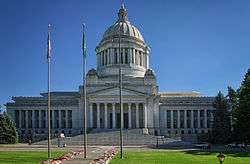 | |
 Washington State Capitol  Washington State Capitol | |
| Location | 416 Sid Snyder Avenue SW, Olympia, Washington 98504 |
|---|---|
| Coordinates | 47°02′09″N 122°54′17″W |
| Area | 230,400 ft2 (21,404 m2) |
| Built | 1922 to 1928 |
| Architect | Walter R. Wilder, Harry K. White |
| Architectural style | American Neoclassical |
| NRHP reference No. | 79002564 |
| Added to NRHP | June 22, 1979 |
History
After Olympia became capital city of the Washington Territory in 1853, the city's founder, Edmund Sylvester, gave the legislature 12 acres (4.9 ha) of land upon which to build the capitol, located on a hill overlooking what is now known as Capitol Lake. A two-story wood-frame building was constructed on the site, where the legislature met starting in 1854.[1] When President Benjamin Harrison approved Washington's state constitution in 1889, he donated 132,000 acres (530 km2) of federal lands to the state with the stipulation that income from the lands was to be used solely for construction of the state capitol.[2]
The legislature formed the State Capitol Commission in 1893 to oversee the creation of a new capitol on the property in Olympia. The commission had a nationwide competition to find an architect and chose the submission of Ernest Flagg. Construction began on Flagg's plan, but was soon stalled by poor economic conditions with only the foundation completed. When the legislature finally approved an appropriation of additional funds in 1897, newly elected Governor John Rogers vetoed it. Rogers advocated the purchase of the existing Thurston County Courthouse in downtown Olympia, now known as the "Old Capitol" and home to the Office of Superintendent of Public Instruction. The legislature approved the new location and began meeting there in 1905.
The courthouse became the location of all agencies of the state government and within a few years the legislature decided the building was too small and a new State Capitol Commission convened in 1911. This time, the commission was interested in constructing a group of buildings to serve as the capitol rather than a single facility and selected the design submitted by the company Walter Wilder and Harry White. Wilder and White's designs were influenced by the Olmsted brothers who served as consultants from 1911 to 1912 and designed and supervised the landscaping for the campus from 1927 to 1931. Construction of the campus began in 1912, and the Temple of Justice was completed in 1920, followed by the Insurance Building and the power and heating plant. After multiple revisions of the plans, the Legislative Building was completed in 1928. Additional buildings on the campus were constructed during the next several decades.
The Capitol Campus was placed on the National Register of Historic Districts in 1974 and contains or contributes to some of the most valued views in the State including the Olympic Mountains, Puget Sound, Mt. Rainier, the Capitol Dome and the Capitol Group of buildings on the hill. The design of the Capitol Campus is a grand example of the City Beautiful style of the Progressive era of the early 20th Century
Buildings
Located on the campus are the Legislative Building, Temple of Justice, John A. Cherberg Senate office building, Irv Newhouse Senate office building, Insurance Building, John L. O'Brien House office building, Joel M. Pritchard Building, and several other office buildings. The Capitol Conservatory, built in 1939 by the Works Progress Administration, housed various types of flora until it was permanently closed on September 5, 2008.[3] The campus also hosts many veterans' memorials.[4]
The state seal, which is featured throughout the buildings on the state flag, tapestries, railing, door handles and elsewhere, was designed by Olympia Jeweler Charles Talcot by making two circles and putting a two-cent stamp of George Washington in the middle.[5] There is even a bronze version of the seal in the floor of the rotunda. Over time, George Washington's nose has worn down due to foot traffic on it and it is now roped-off to prevent further damage.
Legislative Building
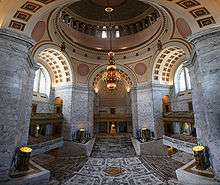
The Legislative Building houses the chambers of the Washington State Legislature and offices of several elected officials. This building is the dominant feature of the capitol grounds, with its dome 287 feet (87 m) high, making it the tallest self-supporting masonry dome in the United States, and fifth tallest in the world, surpassed only by St. Peter's Basilica in Rome, St. Paul's Cathedral in London, Global Vipassana Pagoda in Mumbai, and Santa Maria Del Fiore in Florence.[6] A number of features in the structure commemorating Washington's addition to the Union as the 42nd state—42 steps lead to the building's North entrance and one of the four 42-star flags owned by the state is displayed in the State Reception Room. Flags with this number of stars were never official because of the admission of Idaho shortly after Washington.[7]
The building has a rectangular footprint and is constructed of brick and concrete and faced on the exterior with limestone quarried from Wilkeson, Washington. The structure consists of four floors with the dome at the center that reaches a height of 287 ft (87 m) on the exterior and 175 ft (53 m) from the floor.[6] The first floor is within the raised base and houses offices. The second and third floors are surrounded by Doric columns and capped with a cornice that encircles the building. The fourth floor is covered with a gabled roof that is situated behind the cornice on the third floor. On the north facade, the entrance is in a portico framed by eight Corinthian columns reached by 42 granite steps. A similar portico is on the south facade but it covers a vehicle ramp to the lower level instead of steps. The dome is surrounded by four small sandstone domes and capped by a lantern and lightning rod. The floors and many interior walls are covered by Alaskan marble and marble from Belgium, France, Germany, Italy are used in other parts of the interior.[7]
All lamps and Roman fire pots in the rotunda were made by Louis Comfort Tiffany, son of Charles Lewis Tiffany, founder of Tiffany and Company. These comprise the largest collection of Tiffany bronze in the world and Tiffany's last large commission before his death in 1933. The 10,000 lb (4,500 kg) chandelier above the rotunda is suspended 50 feet (15 m) above the floor by a 101 feet (31 m) chain and measures 25 feet (8 m) tall. It could fit a full-size Volkswagen Beetle if put in sideways and features life-size faces, human figures, and 202 lights.[7]
The Legislative Building is also home to a large brass bust of George Washington. Over time, the nose on the bust has become shiny from visitors rubbing it for good luck.
Other buildings

Facing the Legislative Building is the Temple of Justice, home to the State Supreme Court and the State Law Library. Until 1924, the unused boiler and coal rooms located under the Temple of Justice housed the Division of Highways Testing Laboratory, which would later become the Department of Transportation Materials Laboratory.[8]
The Governor's Mansion is located immediately west of the Legislative Building. Built before the rest of the capitol campus in 1908, the four-story Georgian-style mansion was intended as a temporary structure, and over the years the state legislature has considered replacing it with an office building or a new mansion. The legislature decided to renovate and remodel the existing building in 1973, and since then the private, non-profit Governor's Mansion Foundation has maintained it.
Art and monuments

There are 18 major art installations and monuments on the campus.[9] The Winged Victory monument, commemorating World War I, is one of the most prominent. Sculpted by Alonzo Victor Lewis from bronze, its granite pedestal has four inscriptions. Dedicated May 30, 1938, the monument has been restored numerous times since then.[10] The Tivoli Fountain replica was designed by the architects Wohleb, Wohleb, and Bennett. Inscribed upon it is "Replica of the Tivoli Fountain—Tivoli Park, Copenhagen, Denmark. Presented to the State of Washington by Olympia-Tumwater Foundation. Peter G. Schmidt, President. 1953."[11] Other points of interest include World War II, Korean War, Vietnam War, medal of honor, POW–MIA, and law enforcement memorials; Arc of Statehood; Boiler Works; Du Pen Fountain; Mysteries of Life; Sea to Sky; The Shaman; an untitled sculpture by Lee Kelly (1973); Territorial Sundial; the Water Garden; and Woman Dancing.[12] General George Washington, a colossal portrait by Avard Fairbanks, is placed in the reception room (another is installed at Washington University Medical School in Washington, D.C.).
Natural disasters
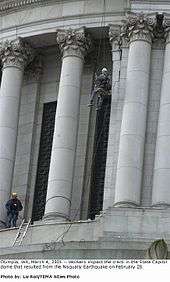
Three major earthquakes have affected the capital since its construction. The first, in 1949, damaged the cupola of the Legislative Building's dome so badly it had to be completely replaced. A 6.5 magnitude earthquake in 1965 had even worse results, with the dome's brick buttresses left in such poor condition that a major aftershock could have caused them to collapse entirely, according to a state report.[13] The state performed work after both earthquakes to reduce the impact of future occurrences, and performed additional seismic improvements in 1975. The Nisqually earthquake of 2001 caused further damage, including a splintered buttress, but the earthquake-resistance work prevented more serious harm to the building.[14]
Wilder and White's designs for the dome, weighing 26,000 metric tons, called for the dome to be fixed to its supporting structures by gravity instead of by any bolts or fasteners. During an earthquake, the dome could shift, along with the sandstone columns supporting it. The columns moved as much as three inches (76 mm) during the Nisqually earthquake. Renovations completed in 2004 by Design Company EYP Architecture & Engineering fixed the dome permanently to the rest of the building.
Quirks of law and security
Because the Capitol grounds are outside the normal jurisdiction of Olympia and Thurston County, the sheriff and city police do not investigate crime on the Capitol campus. The Washington State Patrol is responsible for law enforcement and investigations on the Capitol grounds as well as at the Old Capitol Building and adjoining Sylvester Park in downtown Olympia. The Senate and House also have their own security staff.
After the September 11th attacks, there was a security checkpoint at the entrance to the Capitol building, complete with magnetometer and x-ray machine, but security has since reverted to its original state. The Capitol is one of the few in the country, along with Texas and Kentucky, with no restrictions on carrying firearms.[15]
Controversies
In December 2008, an atheist sign was displayed adjacent to a nativity scene in the State Capitol as part of a Christmas display causing widespread media coverage and controversy.[16] The sign was stolen, but eventually found and returned to the Capitol.[17] There was a rapid influx of requests from individuals and groups wanting to display other material, including a Festivus pole[18] and a request by the Westboro Baptist Church to display a sign saying (among other things) "Santa Claus will take you to hell."[19]
Gallery
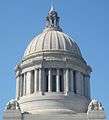 The dome and lantern of the Legislative Building.
The dome and lantern of the Legislative Building. Panoramic view of the Legislative Building and Temple of Justice.
Panoramic view of the Legislative Building and Temple of Justice.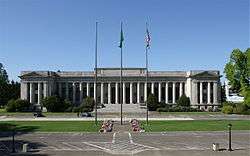 Entrance to the Temple of Justice, facing the Legislative Building.
Entrance to the Temple of Justice, facing the Legislative Building. The law library in the Temple of Justice.
The law library in the Temple of Justice. The interior of the Senate Chamber in the Legislative Building.
The interior of the Senate Chamber in the Legislative Building.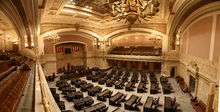 The House of Representatives Chamber, also in the Legislative Building. Note the county names along the ceiling.
The House of Representatives Chamber, also in the Legislative Building. Note the county names along the ceiling. A view of the Old Capitol with statue of J. R. Rogers, first governor of Washington State.
A view of the Old Capitol with statue of J. R. Rogers, first governor of Washington State.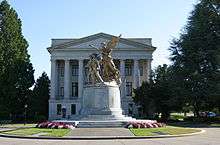 The Insurance Building.
The Insurance Building. The rotunda of the Legislative building with chandelier and Roman fire pot.
The rotunda of the Legislative building with chandelier and Roman fire pot.
 Washington State Capitol Building at night
Washington State Capitol Building at night The Capitol from Budd Bay
The Capitol from Budd Bay.jpg) Winged Victory (World War I memorial)
Winged Victory (World War I memorial)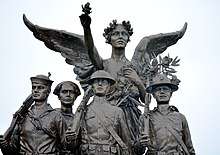 Winged Victory (detail)
Winged Victory (detail)
References
- General
- Johnston, Norman J. Washington's Audacious State Capitol and Its Builders. Seattle: University of Washington Press, 1988.
- Specific
- Don Brazier (2000). History of the Washington State Legislature 1854–1963 (PDF). Olympia: Washington State Senate. p. 3,57.
- Sylvester v. Washington, 215 U.S. 80 (U.S. Supreme Court 1909).
- "About Us". Friends of the Capitol Conservatory. 5 August 2009. Retrieved 2011-06-17.
- "Memorials and Artwork Online Tour". 15 November 2010. Retrieved 2011-06-17.
- "History of the State Seal". Washington Secretary of State. Retrieved 2011-06-17.
- "Capitol Facts & History". Washington Department of Enterprise Services. Retrieved 2013-09-22.
- "Capitol Virtual Tour". Washington Department of General Administration. Retrieved 2011-06-17.
- Kit Oldham (28 January 2005). "Division of Highways first Testing Laboratory opens in the former boiler and coal rooms of Olympia's Temple of Justice in July 1921". HistoryLink.org. Retrieved 2011-06-17.
- https://des.wa.gov/services/facilities-leasing/capitol-campus/memorials-and-artwork
- "Winged Victory Monument". Washington Department of General Administration. Retrieved 2011-06-17.
- "Tivoli Fountain". Washington Department of General Administration. Retrieved 2011-06-17.
- Washington State Capitol memorials and artwork, Washington State Department of Enterprise Services, accessed November 1, 2019
- David Postman (4 March 2001). "Is Capitol dome at risk? Huge stone columns knocked out of line". The Seattle Times. seattletimes.nwsource.com. Retrieved 2011-06-17.
- David Postman (5 March 2001). "Capitol did 'remarkably well'". The Seattle Times. seattletimes.nwsource.com. Retrieved 2011-06-17.
- "As gun laws debated, state Capitol welcomes firearms". Seattle Times. 2013-02-09. Retrieved 2013-04-14.
- "Interview: Bill O'Reilly Vs. Megyn Kelly Over Washington State's Anit-Religion Display in Capitol Building". FoxNews.com. 5 May 2008. Retrieved 2011-06-17.
- Mallory Simon (5 December 2008). "Missing atheist sign found in Washington state". CNN. CNN.com. Retrieved 2011-06-17.
- "Coming to Capitol: 'Festivus' display". KOMO-TV. 5 December 2008. Retrieved 2011-06-17.
- "Radical church wants 'Santa will take you to hell' sign in Olympia". Seattlepi.com. 11 December 2008. Retrieved 2011-06-17.
External links
| Wikimedia Commons has media related to Washington State Capitol. |
- State Capitol Visitor Information
- Governor's Mansion
- Governor's Mansion Foundation
- Washington State Legislature
- Washington State Capitol – Photographs from a visit to the capitol


